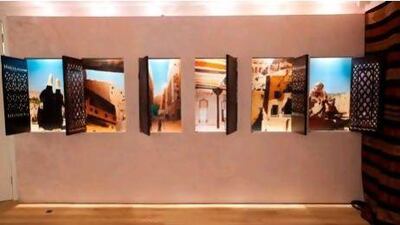We all have our own ideas about what home might look like in the Arab world. Many of them might be traditional views - from the importance of the courtyard in Arab houses to the wooden lattice of the mashrabiya. But a new exhibition in London invites us to think more deeply about the notion of home in the 21st century. Home: Contemporary Architectural Interpretations of the Home in the Arab World brings together designers working across the Middle East, from Bahrain to Lebanon, Iraq to Qatar and Egypt to Yemen, to discuss how traditions are being challenged and reshaped. It's a hugely satisfying collection of work which points towards an exciting future for the spaces which we inhabit, and we caught up with three of its featured architects and designers.
Qatar
Thomas Modeen from Virginia Commonwealth University, in collaboration with Independent Architects and the State of Qatar, explains a new take on the mashrabiya:
Mashrabiya, as I'm sure most people know, are the traditional Middle Eastern privacy screens, usually made out of wood. We wanted to redesign and update this regional icon, so ours is constructed with paper, using laser cutting and 3D printing so that it shimmers and flickers under, say, an air conditioning unit.
I'm originally from Finland but I've lived in Oman, Kuwait and now Qatar, and most of the design in the houses I've visited is quite exuberant and baroque, but when you look at the landscape it's very minimal. So we wanted to try to celebrate that and make the design reflective of the subtleties there are in the region. This isn't some conceptual idea for an art gallery, though; I'd genuinely like to think it can be used in the home. The printing technologies now mean that it can be bespoke to any space and filter light in at the correct level.
Yemen
Salma Samar Damluji of The Daw'an Mud Brick Architecture Foundation argues that the Gulf needs to look back to see the future:
Often earth and mud-brick buildings are considered to be something of the past, something we have to be nostalgic about. But the foundation is not just about conservation. It's more concerned with encouraging builders and architects to think about and use these sophisticated design and construction techniques. We want to maintain the idea of the mud brick building so we can show that this is fantastic architecture that can be used in the future in a country rich with resources.
Our installation begins with a shuttered wall, the shutters represent of the divide between the landscape and the city and the separation between the interior and exterior, the public and the private. Open the shutters and you see images of Masna'at 'Urah, for example, an area in which we're working now.
Recognition for our work is coming slowly. We've got a lot of praise for thinking about building in a more ecological way and we just received a global award for sustainable architecture in Paris.
Egypt
Shahira Fahmy of Shahira Fahmy Architects, in collaboration with Bas Princen and the Embassy of the Arab Republic of Egypt, explores the boundaries between the interior and the exterior of a home:
The concept behind the work came from my research on the "magaz" - the traditional Arabic word for a vestibule that separates the house from the street. And even though they don't really exist in new buildings in Cairo, I began thinking about the boundaries between the public and private, how in fact they can be quite fragile, which is why in this installation I used fabric - it moves and is extendable, just like a home can be.
The fabric installation can be seen as a whole district of four buildings or one home with four rooms that are open and interconnect with each other. The idea is that there is a new type of home emerging; I am a mother, and the only door closed in my home is the bathroom. That's been the major change in my lifetime I think - homes have been opened up and shared. The possibilities for design are much less controlled than before. It's inspiring as an architect to present these new solutions for living.
Home: Contemporary Architectural Interpretations of the Home in the Arab World is at The Mosaic Rooms, London, until Saturday. Visit www.mosaicrooms.org.

